ICRA 2024, May 17, Yokohama, Japan
Choreographic
Swarms
Robots stir visions of ceaseless motion. The study of their movement is a key to the expressivity they project, a language bound to their unique forms and limitations. To grasp this nuanced communication, to choreograph movements both clear and compelling, engineers and artists must forge a shared understanding. Whether in solitude or synchronized groups, robotic expressivity lies in the artistry of motion, a collaboration born of both form and function.
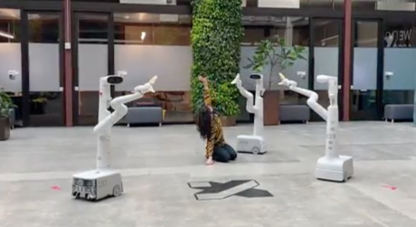
Call for Extended Abstracts/ Short Papers
Important Dates:
- Abstracts (2 to 4 pgs): April 26th 2024
- Decisions Announced: May 3rd 2024
- Tutorial date: May 17th 2024
Short papers/extended abstracts are invited to be presented at a special poster/interactive session as part of the tutorial program. Submissions should be related to the tutorial topic and should represent work relevant to robotic and dance. All submissions will be peer-reviewed and accepted abstracts/short papers will be archived on roboticart.org with the possibility of being invited to publish extended work in a special issue in a suitable journal.
Topics include (non-exhaustive):
-
Human-Robot Interaction
-
Robot motion planning
-
Path planning
-
Human-centred manipulation and navigation
-
Collaborative robotics
-
Human/Robot performances
-
Natural movements in robots
-
Robot Swarms
-
Human motion tracking and analysis
Introduction
In the world of robotics, the future undeniably lies in the swarm. Inspired by the intricate harmonies of nature, robotic swarms stand to reshape industries. Yet, a shared challenge emerges: how to make swarm behavior legible, whether inspired by nature or engineered for specific tasks. Operators must grasp a swarm’s actions for rapid decision-making, while everyday users in social settings need to intuitively understand a swarm’s intent.
The Choreographic Swarm tutorial tackles this with hands-on sessions, keynotes, and talks from both artistic and technical roboticists. The focus extends beyond mastery to creative collaboration and mentorship. Artists and engineers will forge a shared understanding, envisioning the next generation of robots and robot swarms that blend expressivity with purpose.
Keynotes
Alcherio Martinoli
Real-World Robotic Swarms
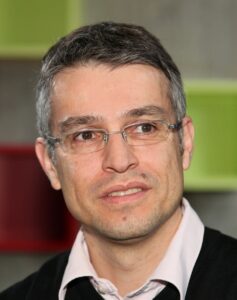 Alcherio Martinoli, holding a Diploma in Electrical Engineering from ETH Zurich and a Ph.D. in Computer Science from EPFL Lausanne, serves as an Associate Professor at the School of Architecture, Civil, and Environmental Engineering. He heads the Distributed Intelligent Systems and Algorithms Laboratory.
Alcherio Martinoli, holding a Diploma in Electrical Engineering from ETH Zurich and a Ph.D. in Computer Science from EPFL Lausanne, serves as an Associate Professor at the School of Architecture, Civil, and Environmental Engineering. He heads the Distributed Intelligent Systems and Algorithms Laboratory.
Ken Goldberg
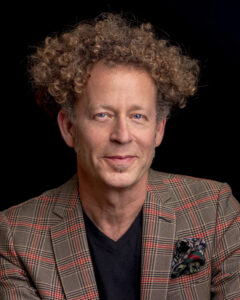 Ken Goldberg has been interested in robots, rockets, and rebels since he was a kid. He’s skeptical about claims that humans are on the verge of being replaced by Superintelligent machines yet optimistic about the potential of technology to improve the human condition. Ken developed the first provably complete algorithm for part feeding and the first robot on the Internet. In 1995 he was awarded the Presidential Faculty Fellowship and in 2005 was elected IEEE Fellow: “For contributions to networked telerobotics and geometric algorithms for automation.” Ken founded UC Berkeley’s Art, Technology, and Culture public lecture series in 1997 serves on the Advisory Board of the RoboGlobal Exchange Traded Fund. Ken is Chief Scientist at Ambidextrous Robotics and on the Editorial Board of the journal Science Robotics. He served as Chair of the Industrial Engineering and Operations Research Department and co-founded the IEEE Transactions on Automation Science and Engineering. Short documentary films he co-wrote were selected for Sundance and one was nominated for an Emmy Award. He lives in the Bay Area and is madly in love with his wife, filmmaker and Webby Awards founder Tiffany Shlain, and their two daughters.
Ken Goldberg has been interested in robots, rockets, and rebels since he was a kid. He’s skeptical about claims that humans are on the verge of being replaced by Superintelligent machines yet optimistic about the potential of technology to improve the human condition. Ken developed the first provably complete algorithm for part feeding and the first robot on the Internet. In 1995 he was awarded the Presidential Faculty Fellowship and in 2005 was elected IEEE Fellow: “For contributions to networked telerobotics and geometric algorithms for automation.” Ken founded UC Berkeley’s Art, Technology, and Culture public lecture series in 1997 serves on the Advisory Board of the RoboGlobal Exchange Traded Fund. Ken is Chief Scientist at Ambidextrous Robotics and on the Editorial Board of the journal Science Robotics. He served as Chair of the Industrial Engineering and Operations Research Department and co-founded the IEEE Transactions on Automation Science and Engineering. Short documentary films he co-wrote were selected for Sundance and one was nominated for an Emmy Award. He lives in the Bay Area and is madly in love with his wife, filmmaker and Webby Awards founder Tiffany Shlain, and their two daughters.
Catie Cuan
Robot Dance
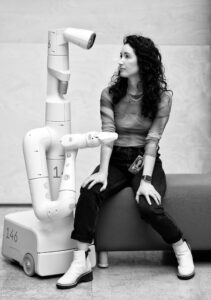 Dr. Catie Cuan, an engineer, researcher, and artist, stands as a pioneer in the emerging domain of ‘choreorobotics.’ Her expertise converges at the crossroads of artificial intelligence, human-robot interaction, and the realm of art. Recently, she successfully defended her PhD at Stanford University’s Mechanical Engineering department, where she also earned a master’s in mechanical engineering.
Dr. Catie Cuan, an engineer, researcher, and artist, stands as a pioneer in the emerging domain of ‘choreorobotics.’ Her expertise converges at the crossroads of artificial intelligence, human-robot interaction, and the realm of art. Recently, she successfully defended her PhD at Stanford University’s Mechanical Engineering department, where she also earned a master’s in mechanical engineering.
Dr. Cuan will share her recent foray into the world of Google’s Everyday Robots, highlighting an innovative experiment that transforms these robots from mere physical tools into musical instruments. Their joint velocities are mapped onto musical tracks, allowing the robot to create music while in motion, resembling a ‘music mode.
Program
8:15 |
WELCOME |
David St-Onge |
8:30 |
KEYNOTE 1: Robot DanceThis is a special joint presentation with the workshop on “Speed-dating to long-term relationships“: a paired Talk between an Artist and a Roboticist. |
Catie Cuan and Ken Goldberg |
9:15 |
Designing robot expressivity: DESSAIM |
David St-Onge and Hélène Duval |
9:25 |
Designing robot expressivity: Human-Robot Experience (HRX) |
Petra Gemeinboeck and Rob Saunders |
9:35 |
Designing robot expressivity: Algorithmic Expressivity |
Damith Herath |
9:45 |
Playful and intuitive motion design tools – RC |
Audrey Rochette and Alexandra Mercader |
10:00 |
Coffee break |
Play with the arms! |
10:30 |
Playful and intuitive motion design tools |
David St-Onge and Alexandra Mercader |
10:45 |
INTERACTIVE 1: Design motion for Gen3 lite arm. |
Participants (Instructions) |
12:30 |
Lunch |
|
13:15 |
KEYNOTE 2: Real-World Robotic Swarms |
Alcherio Martinoli |
14:00 |
Programming swarms and behaviour composition |
Giovanni Beltrame and Ali Imran |
14:15 |
Lightning Talks |
Selected abstracts from CfC |
14:30 |
Coffee break |
|
15:00 |
Designing group expressivity |
Audrey Rochette and Hélène Duval |
15:15 |
INTERACTIVE 2: Designing emergent swarm choreography for 10 Gen3lite |
Participants (Instructions) |
16:45 |
Group discussion and individual surveys |
Participants + organisers + speakers |
17:15 |
Closing remarks |
David St-Onge |
Organisers
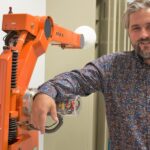 David St-Onge, Director of INIT Robots and Associate Professor at École de technologie supérieure, 1100 Notre-Dame W., Montreal, Canada, [email protected], https://initrobots.ca/en/team/david-st-onge.
David St-Onge, Director of INIT Robots and Associate Professor at École de technologie supérieure, 1100 Notre-Dame W., Montreal, Canada, [email protected], https://initrobots.ca/en/team/david-st-onge.
 Hélène Duval, Adjunct professor at the Dance department of the Université du Québec à Montréal, 840 Cherrier St., Montréal, Canada, [email protected], https://initrobots.ca/en/team/helene-duval.
Hélène Duval, Adjunct professor at the Dance department of the Université du Québec à Montréal, 840 Cherrier St., Montréal, Canada, [email protected], https://initrobots.ca/en/team/helene-duval.
 Petra Gemeinboeck, Associate professor at Swinburne University of Technology, Melbourne, Australia, [email protected], https://www.swinburne.edu.au/research/our-research/access-our-research/find-a-researcher-or-supervisor/researcher-profile/?id=pgemeinboeck
Petra Gemeinboeck, Associate professor at Swinburne University of Technology, Melbourne, Australia, [email protected], https://www.swinburne.edu.au/research/our-research/access-our-research/find-a-researcher-or-supervisor/researcher-profile/?id=pgemeinboeck
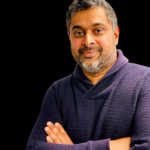 Damith Herath, Associate professor at University of Canberra, [email protected], https://www.damith.org/
Damith Herath, Associate professor at University of Canberra, [email protected], https://www.damith.org/
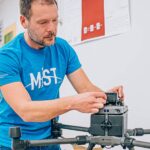 Giovanni Beltrame, Director of MIST and Professor at Polytechnique Montréal, 100 Polytechnique R., Montréal, Canada, [email protected], https://mistlab.ca/people/beltrame
Giovanni Beltrame, Director of MIST and Professor at Polytechnique Montréal, 100 Polytechnique R., Montréal, Canada, [email protected], https://mistlab.ca/people/beltrame
 Rob Saunders, Associate Professor in Computational Creativity at Leiden Institute for Advanced Computer Science, Leiden University, The Netherlands, [email protected], https://www.universiteitleiden.nl/en/staffmembers/rob-saunders
Rob Saunders, Associate Professor in Computational Creativity at Leiden Institute for Advanced Computer Science, Leiden University, The Netherlands, [email protected], https://www.universiteitleiden.nl/en/staffmembers/rob-saunders
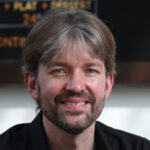 Florent Levillain, Adjunct Professor at Université de Technologie de Compiegne, Roger Couttolenc St., 60200 Compiegne, France, [email protected]
Florent Levillain, Adjunct Professor at Université de Technologie de Compiegne, Roger Couttolenc St., 60200 Compiegne, France, [email protected]
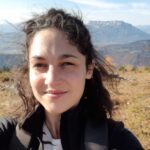 Audrey Rochette, Master student at the Dance department of the Université du Québec à Montréal, 840 Cherrier St., Montréal, Canada, [email protected], https://initrobots.ca/en/team/audrey-rochette.
Audrey Rochette, Master student at the Dance department of the Université du Québec à Montréal, 840 Cherrier St., Montréal, Canada, [email protected], https://initrobots.ca/en/team/audrey-rochette.
 Alexandra Mercader, Post-doctoral fellow at INIT Robots, École de technologie supérieure, 1100 Notre-Dame W., Montreal, Canada, [email protected], https://initrobots.ca/en/team/alexandra-mercader.
Alexandra Mercader, Post-doctoral fellow at INIT Robots, École de technologie supérieure, 1100 Notre-Dame W., Montreal, Canada, [email protected], https://initrobots.ca/en/team/alexandra-mercader.
 Ali Imran, PhD at INIT Robots, École de technologie supérieure, 1100 Notre-Dame W., Montreal, Canada, [email protected], https://initrobots.ca/en/team/ali-imran.
Ali Imran, PhD at INIT Robots, École de technologie supérieure, 1100 Notre-Dame W., Montreal, Canada, [email protected], https://initrobots.ca/en/team/ali-imran.
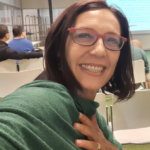 Elisabetta ZIBETTI
Elisabetta ZIBETTI
Assistant Professor at CHArt Laboratory ( Human and Artificial Cognition Lab) Paris 8 University, France
http://laboratoire-chart.fr/